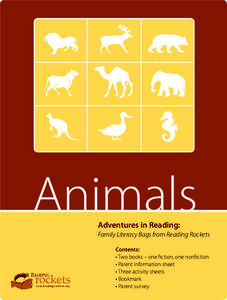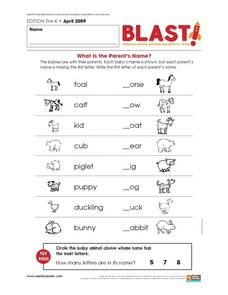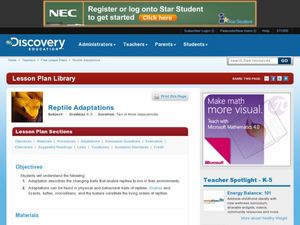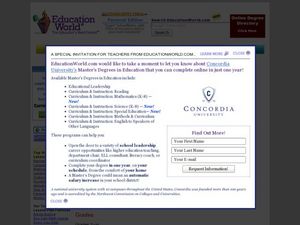Curated OER
Baby Elephant Orphans Get New Home, Families
Students react to a series of statements about elephants, then read a news article about how workers at an elephant orphanage are working to return the animals to the wild. In the animal studies and current events lesson, the teacher...
PBS
Reading Adventure Pack: Animals
Scholars explore the animal kingdom with help from two texts, Blueberries for Sal by Robert McCloskey and A Bed for the Winter by Karen Wallace. The literature and informational text set the learning stage for thoughtful discussion and...
Curated OER
Help the Mommy Animal Find Her Babies
In this language arts worksheet, students learn the names of mother animals and the babies by examining 4 sets of pictures. Using the word bank, students write the names by the pictures of the big and little animals. Then students trace...
Curated OER
Farm Animals - Mothers and Babies - "Are You My Baby?"
Students listen to a teacher read aloud and discuss the farm animals. They participate in an role playing activity that explains how mother mammals recognize their young by their scent.
Curated OER
Animals and Animal Babies
Students examine how some animal young are similar to the adult. They look at pictures of various animals and their young and identify if they look similar or not similar to the adult animal, and draw a picture of a baby and parent...
Curated OER
Animals and Environments
Students listen to stories and identify animals and their young. In this animals instructional activity, students view videos about farm animals and create illustrations to show how animal babies change over time. Students discuss...
Curated OER
Help the Duck Find Her Babies
Students study the basic need for animals to attract mates and reproduce young.
Curated OER
Penguin Parents are Cool
Fourth graders explore the lives of penguins and the relationship between them and their parents. They compare and contrast penguin populations in various areas of the world as well as their nesting sites. After constructing a penguin...
Curated OER
Animal Babies on the Farm
Students identify different farm animals and match farm animal babies to their parent(s). They recognize more specific gender terminology for farm animals.
Curated OER
Dogfighting Hurts Animals
Pupils discuss dogfights and relate caring for a baby to caring for their animal. In this dogfighting lesson plan, students view video about dogs forced to fight and relate to parenting skills. Pupils become familiar with ways to help...
Curated OER
Farm Babies
Students use flash cards to match the mother names to the baby names for farm animals. In a designated "barn" in the room, students simulate being mothers, fathers, and babies. The baby must find his mother and father. Students visit...
Curated OER
Parent and Baby Lookalikes
Students research baby animals, their special names and the vocabulary to describe their relative sizes through discussion, listening to a Salish story, looking at pictures, and creative artwork . They will also explore the significance...
Curated OER
What is the Parent's Name?
In this early childhood word recognition worksheet, students read the 8 baby animal's names and fill in the blanks of the matching adult animal's names with the correct letter.
Curated OER
Companion Animals
In this animals worksheet, students discuss their own pets. Then students answer 3 questions having to do with pets and overpopulation. Students then separate into debate teams and debate licensing and breeding issues.
University of Pennsylvania
Evolution by Natural Selection
A diagram, data table, and reading passage top this resource. Through it, biology beginners are introduced to the concept of natural selection. They answer some questions and then participate in a simulation using fabric as a habitat and...
Curated OER
Form and Observation
Use a familiar song and adorable baby animal pictures to teach youngsters about genetic variation. Begin by listening to "Twelve Variations on 'Ah vous dirai-je Maman,'" which you will need to find online (there are several versions...
Oklahoma State University
Hairy Heredity
Young scholars learn that heredity comes down to the flip of a coin with this cross-curricular math and science lesson. Using smiley faces as a model, students toss coins to determine which dominant or recessive traits will be passed on...
Curated OER
Growing Up
Help little learners understand what happens during the human life cycle. Each slide defines and poses discussion questions regarding each phase of human life. Infancy, childhood, the teen years, adulthood, and old age are all covered....
Curated OER
Genetics PowerPoint
If mom is bald, will her babies be bald? Here is a practical presentation that can answer that question. Viewers can take notes on the difference between dominant and recessive genes, mutations, and heritability. A large portion of the...
Curated OER
Reptile Adaptations
Pupils research animal adaptations. In this adaptations instructional activity, students research the physical and behavioral adaptations of animals. Pupils create a diagram of their animal labeling it's adaptations.
Curated OER
Animals
Second graders define and describe the characteristics of a mammal and a mammal's importance to man. They also describe the life cycle of a frog and compare and contrast a larva and an adult frog. Finally, 2nd graders study and explain...
Curated OER
Baby Animals
In this baby animal graphic organizer, students write in four examples of young animals that look like their parents, and two examples of young animals that look different from their parents.
Curated OER
Look Alikes
Third graders compare and contrast the physical features of parents and offspring. In this life science lesson plan, 3rd graders classify a set of animal pictures according to their similarities. They share and explain their work in class.
Curated OER
Baby Animals Debut at Zoos
Students determine the names of animal babies, then read a news article about zoo's experiencing animal births. In this current events lesson, the teacher introduces the article with vocabulary activities, then students read the news...

























